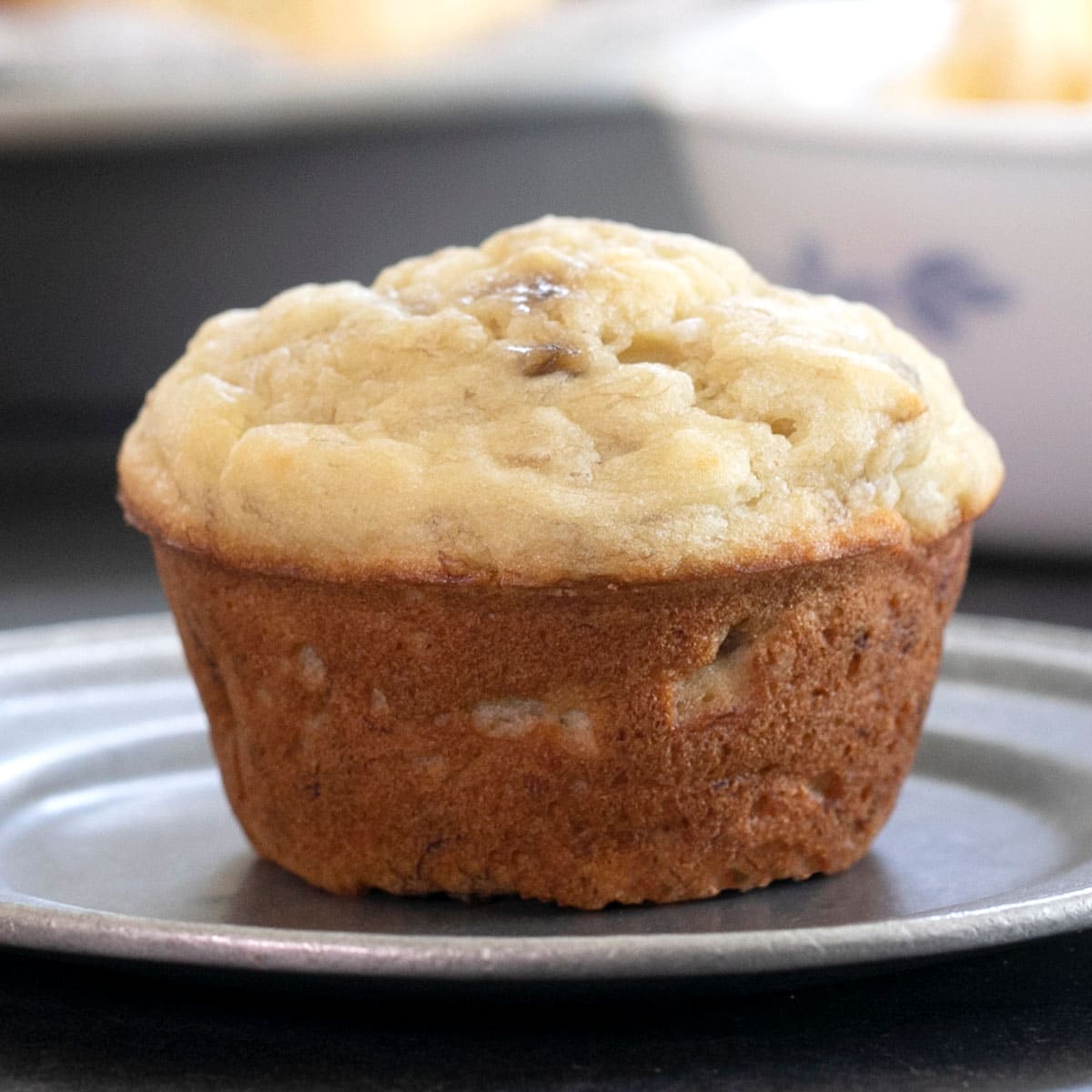

Moist, tender, and fluffy gluten-free banana muffins in the classic style, made with plenty of mashed ripe bananas and buttermilk for the perfect texture.
As long as you have basic gluten free ingredients in the cupboard, and a few ripe bananas, you'll only need one bowl and about 30 minutes to make a very easy gluten free muffin!
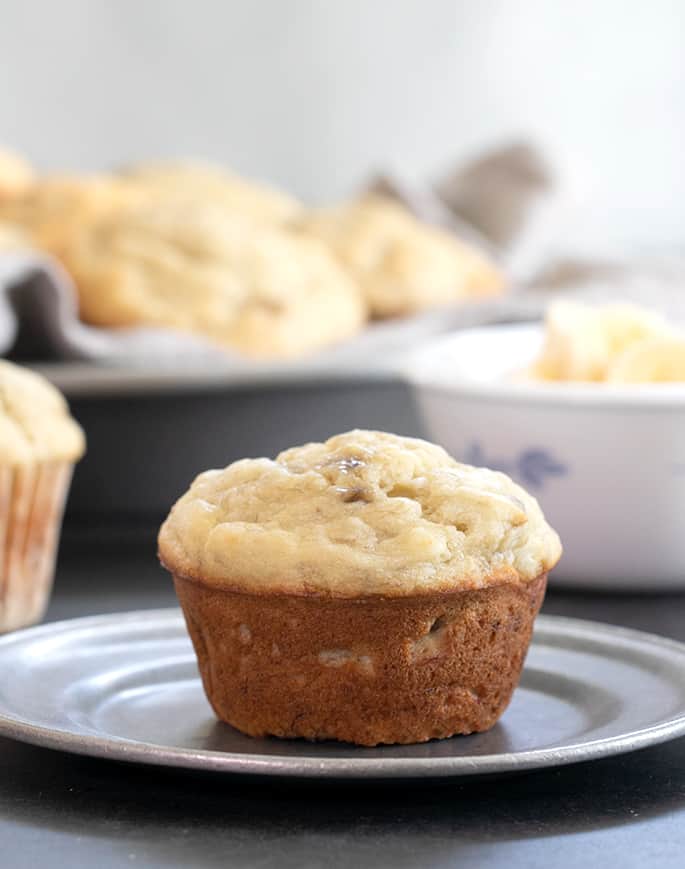
WANT TO SAVE THIS RECIPE?
What makes these “the best” gluten-free banana muffins?
The versatility and ease of this recipe are two of the key elements that make it so good. Their soft, tender texture and beautiful banana flavor make these one of the best muffins you'll find.
And the recipe includes buttermilk, which tenderizes your gluten-free banana muffins. But don't get excited and try using buttermilk in my already-tender banana bread recipe – that much liquid would make the loaf cave in on itself during baking. For that recipe, stick with the sour cream.
Like our gluten-free morning glory muffins which are packed the moisture and sweetness of shredded carrots and apples, these banana muffins can handle the extra moisture.
This recipe is really versatile and forgiving. Sometimes when I bake banana muffins, I even place a thin slice of ripe banana right on the top of the batter in each well. Adding that banana slice does add some extra moisture, so plan to bake the muffins for another couple of minutes.
How to make gluten-free banana muffins
- Whisk together dry ingredients (gluten-free flour blend, cornstarch, baking powder and soda, salt and sugar);
- Add the wet ingredients to the center (butter, eggs, buttermilk, vanilla, mashed bananas) and mix to combine;
- Divide the wet banana muffin batter among the greased wells of a muffin tin;
- Bake at 350°F for about 20 minutes;
- Let cool for about 5 minutes and then transfer to a wire rack.
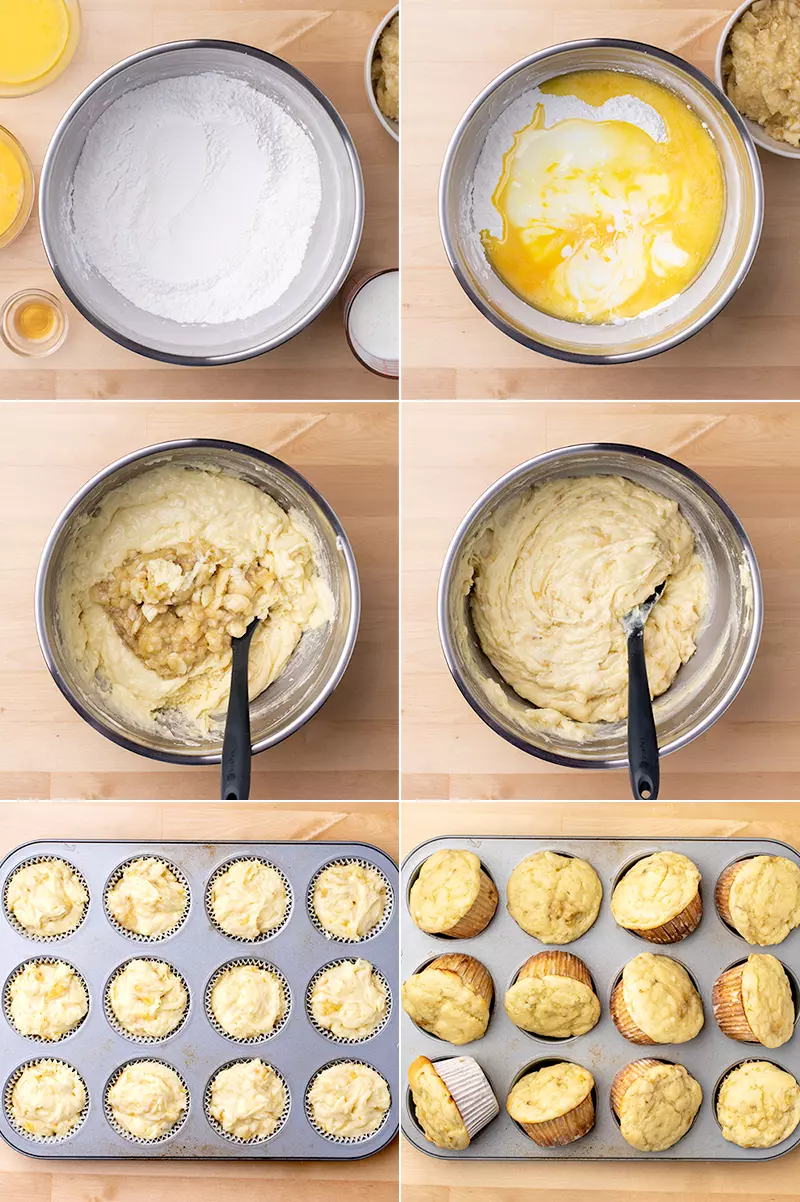
Tips for baking gluten free banana muffins
When I shared my recipe for easy mix-in gluten-free muffins, we talked about how that's the perfect “plain” muffin recipe. It can easily handle mix-ins that don't add extra moisture, like raisins and chocolate chips—or even a crumble topping (the best!).
Recipes like this for banana muffins, gluten-free blueberry muffins and gluten free strawberry muffins are different, and each need their own special recipe. Adding fruit with a lot of moisture like blueberries, strawberries and bananas changes the moisture in the muffin batter and it must be accounted for.
Follow the recipe!
This recipe is easily made in one bowl and doesn't call for beating the butter and sugar first. That's part of the reason that it specifies butter that's been melted and cooled, rather than at room temperature.
In this recipe, you make the banana muffin batter by whisking the dry ingredients then mixing in the individual wet ingredients to make a soft, thick banana muffin batter. Fill the wells of your prepared muffin tins all the way, and you're ready to bake them to perfection!

Use the right gluten free flour for banana muffins
For my recipe, it's Better Batter classic gluten-free flour blend (or my mock Better Batter recipe). I've made these gluten free banana muffins so many times using this blend, and they always come out perfectly!
Can I use a different gluten-free flour?
For the best results, I highly recommend sticking with Better Batter gluten-free flour classic blend, Cup4Cup, or one of my mock blends. Of course, if you like to experiment, give it a try! There are lots of gluten-free flours out there, but I can't promise results if you use an unbalanced blend and/or one with a gritty rice flour.
A word of caution: I don't recommend using straight coconut flour in this recipe as it absorbs tons of moisture; your muffins will turn out dense and crumbly. The same goes for straight almond flour, which requires a different recipe (and luckily we have a recipe for almond flour banana muffins!).
Aim for the same size muffins for an even bake
Making sure that your grain free banana muffins are each the same size is the best way to ensure even baking of all the muffins in the tin. Try to fill each well in your muffin pan to roughly the same level and they will bake evenly.
Use a greased or lined muffin tin
You can bake these muffins in a tin that is simply greased or also lined with paper muffin liners. I usually prefer to use muffin liners, as you get a slightly higher dome that way. Just be sure to let the muffins cool completely before you attempt to peel back the liner, or it will stick!
Baking with bananas
As long as you have a freezer, never worry about buying too many bananas. Like avocados, bananas ripen and demand to be eaten, or they'll go bad.
But unlike avocados, bananas can be peeled, sliced, frozen, and stored until you need them. I freeze chopped bananas in a single layer on a lined baking sheet, then pile them into a zip-top bag and return them to the freezer.
Frozen banana chunks are perfect for defrosting to make muffins like these and our cinnamon swirl banana bread. Defrost them on the counter, or in the microwave at 50% power. They'll seem to have a lot more liquid than fresh, mashed bananas, but don't drain them! Just bake with them as is.
Frozen banana chunks make lovely n'ice cream. If you don't have bananas on hand that are ripe enough for baking, you can try placing them in a paper bag with an apple to trap the ethylene gas that causes natural ripening.
“Ripening” bananas in the oven won't work. Unfortunately, although the skins of fully unripe bananas will brown in the oven, the bananas inside won't be nearly sweet enough for baking.
Use room temperature ingredients only
All the ingredients in this recipe need to be at room temperature to make sure they combine properly.
I’ve only specified the temperature of the wet ingredients like butter, eggs, and buttermilk since those are the ingredients that are stored in the refrigerator to prevent spoiling. The butter in this recipe is melted and then cooled to prevent its cooking the eggs.
If you’ve forgotten to leave your eggs out on the counter to warm to room temperature, just place them in a bowl of warm (not hot) water and allow them to sit for about 15 minutes.
If your buttermilk is cold, try microwaving it in 15-second intervals, stirring in between to prevent overheating. If you do overheat the buttermilk, just allow it to cool on the counter for a few minutes until it’s no longer hot to the touch.
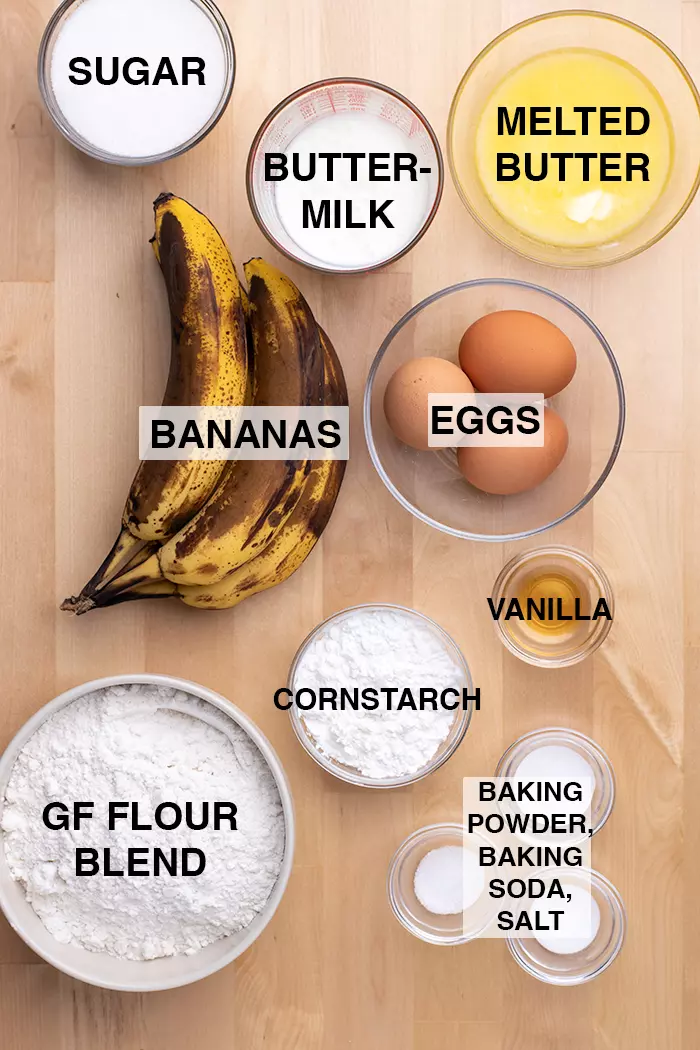
Storage and refreshing instructions
You can store leftover banana muffins at room temperature in a sealed container for 3 to 5 days. To refresh a muffin that has started to dry out a bit, run it under cold water and then place in the toaster oven. Put the temperature to 300°F or lower, and let the muffin warm up. It will be close to good as new!
To store muffins, make sure they're completely cooled first. Baked goods that are still warm give off steam, and if you trap that steam in a sealed container, your muffins will turn soggy.
Freezing instructions
For longer storage, freeze your muffins for up to 2 months. Place them in a single layer on a small rimmed tray or baking sheet, and into the freezer. After a few hours, transfer them to an airtight container, such as a zip-top bag, and return them to the freezer.
Let frozen muffins thaw on the counter for a few hours, or microwave them for about 25 seconds. You can refresh them by moistening them and putting them in a 300°F toaster oven as described above.
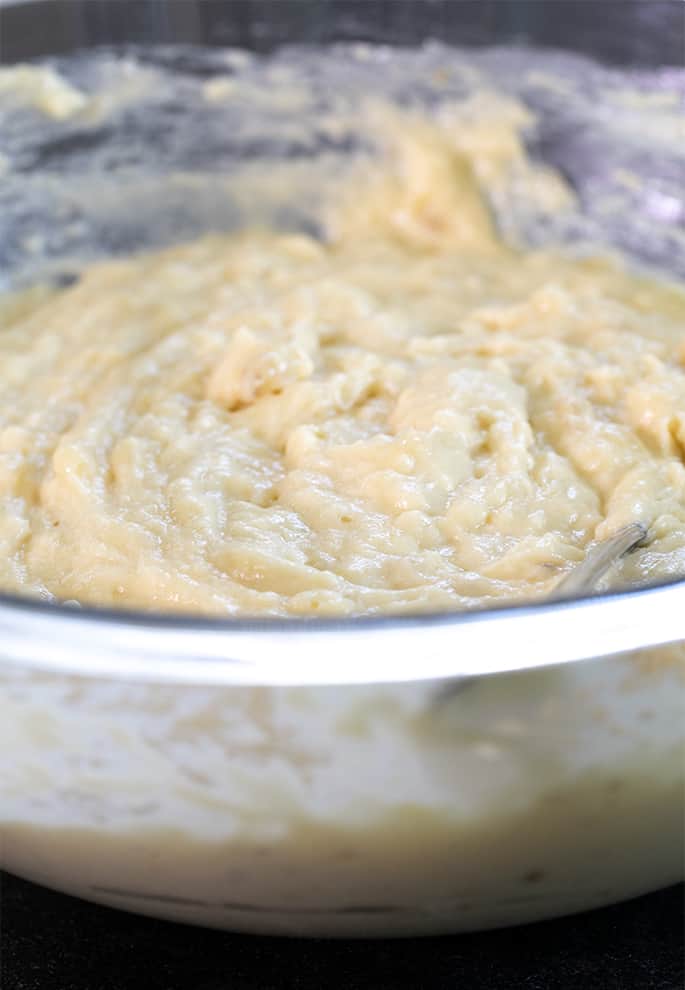
Popular ingredient substitutions
Here are my notes and best guesses to help you bake along if you have these other dietary restrictions.
Dairy free
To make this recipe dairy-free, you have to replace both the butter and the buttermilk. For the butter, my favorite substitute in this recipe is virgin coconut oil, melted and cooled.
I like triple-filtered coconut oil (I buy mine at Trader Joe's) because it doesn't have any coconut flavor. I love coconut, but that's not the flavor we're going for in this recipe.
For the buttermilk, my favorite way to substitute it is by mixing 1/2 cup (about 130 grams) dairy-free plain yogurt with 1/2 cup (4 fluid ounces) nondairy milk. In fact, when I don't have buttermilk on hand, that's the dairy substitute I use, and it works great.
Egg free
Making this recipe egg-free is a tough one, as there are 3 whole eggs in the recipe. Once a recipe has more than 2 eggs in it, my confidence in the likely success of using an egg replacer decreases.
You can try using one “chia egg” (1 tablespoon ground chia seeds + 1 tablespoon lukewarm water, mixed and allowed to gel) in place of each egg. I'm honestly just not that optimistic that it will work that well.
Vegan
Follow the above suggestions for replacing the dairy and eggs, and you'll end up with vegan and gluten-free banana muffins. However, note that with so much substitution, I can't guarantee these will come out close to the way I make them.
You may need to experiment to suit your taste, and be sure that your sugar is made without bone char. Plus, if you're making vegan banana chocolate chip muffins, you'll need dairy-free chocolate chips, too.
Corn free
The cornstarch in this recipe is added because it adds tenderness and lightness to the recipe. It helps keep the muffins tender and not heavy, even though there are 4 mashed bananas in the batter.
You can easily replace the cornstarch with an equal amount of arrowroot. I've also made it with potato starch in place of cornstarch, in a pinch, and had no issues.
If you're using a higher starch flour blend like Cup4Cup, replace the cornstarch with more Cup4Cup. Just measure by weight.
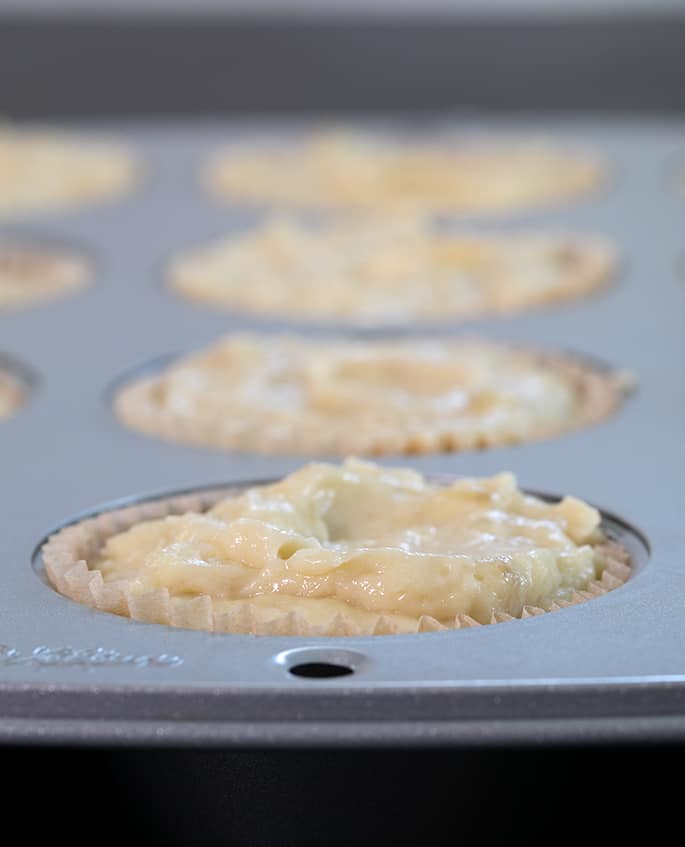
Gluten-free banana muffin variations
As with my easy mix-in gluten-free muffins, these muffins can handle mix-ins with no problem, so long as they don't add extra moisture. Here are some of my favorite variations.
Banana chocolate chip muffins
Is there anything that chocolate chips can't make better? I'm sure there is, but let's not waste time on that. It's so simple to turn these into gluten-free banana chocolate chip muffins.
Add one half of a cup to the batter, but also save some chocolate chips to add to the top of each muffin before popping into the oven, like we did with our plain gluten-free chocolate chip muffins.
Banana nut muffins
You can also turn these very easily into gluten-free banana walnut muffins by adding 2 to 3 ounces of chopped, raw walnuts to the batter. Just fold them in right after you add the mashed bananas.
You can also make these with pecans if they're your nut of choice, or maybe raisins, or maybe something else — let me know if you experiment!
Toppings!
I love tons of banana flavor, but when I want classic gluten-free banana muffins with just a little something extra, I go for toppings. It's so easy to sprinkle on as much or as little as you'd like, and you can even make plain muffins and topped muffins for a mixed crowd or a little variation throughout the week.
As long as you choose a dry topping, the sky's the limit. Some ideas to consider are: coconut chips (interesting flavor combo with the bananas), chopped nuts (walnuts are my favorite), or coarse sugar (not too much).
Craving a gluten free banana cupcake and don't want to make our gluten-free banana cake? Okay, I'll admit these don't have the same consistency as a traditional cupcake, but add just a little bit of vanilla frosting on top, and you can trick yourself. :)
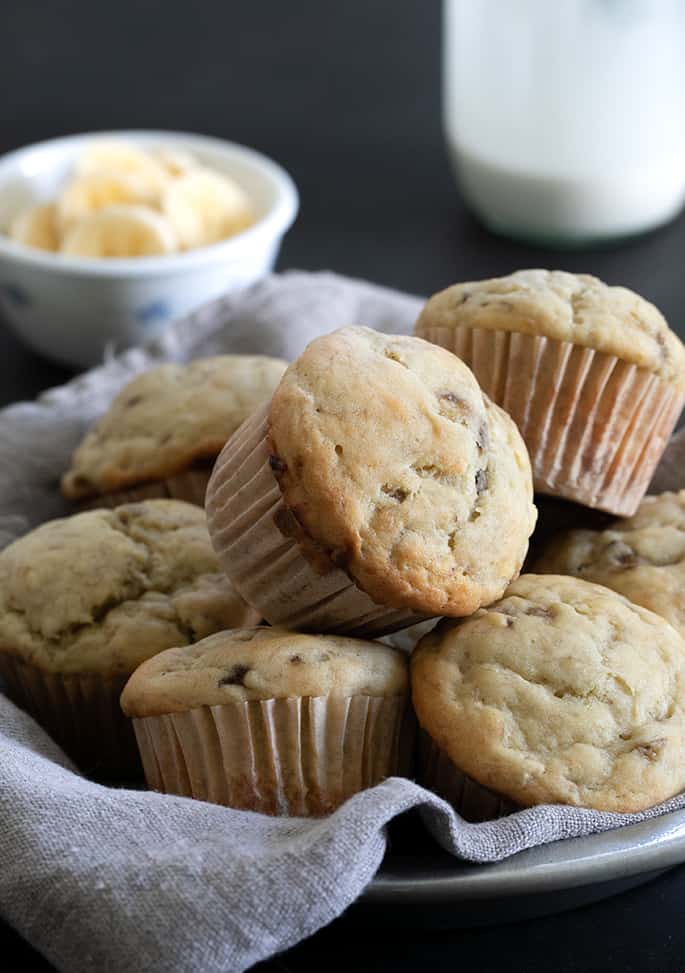
FAQs
No! If you're following a traditional recipe or buying them premade from the store, the answer is typically no. That's because most recipes use conventional wheat flour. If you're following this recipe for gluten-free banana muffins, they're safely gluten free!
Yes! Just be sure they're completely thawed before adding them into the mix. Also note that your frozen bananas will leak water as they thaw; throw it and the bananas into the mix to maintain the right moisture balance.
No! “Souring” regular milk with a bit of vinegar or lemon juice is not a proper substitute for commercially prepared buttermilk in baking.
If you don't have buttermilk, you can always replace it successfully in my recipes that call for it with half (by volume) plain yogurt (dairy or nondairy) and half milk (dairy or nondairy, just unsweetened and unflavored).
You can also replace buttermilk with plain kefir. Watch that texture, since it indicates moisture content, and if you add too much moisture, your muffins will be dense and gooey in the center.
Muffins usually stick to the pan if the pan is an old nonstick muffin tin that has had its nonstick coating worn away, if you don't fully grease the wells of the tin (and you haven't lined the wells of the tin with greaseproof muffin liners.
When baked goods rise in the oven and then fall as they cool, they are usually underbaked so the inside can't support the rise as the steam escapes during cooling. Ironically, it's usually due to an oven that is running too hot, so the outside of the muffin baked to the point of almost burning before the inside could fully bake.
Yes! Follow the same instructions but instead of a standard 12-cup muffin tin, use a 24-cup mini muffin tin. Fill the wells all the way and start checking for doneness around 14 minutes. The mini muffins are done when the top of a middle muffin springs back when pressed gently.
A liquid sweetener like maple syrup can't be used to replace granulated sugar without also reducing the remaining moisture in the recipe. You can try replacing the 3/4 cup of granulated sugar with a bit more than 1/2 cup pure maple syrup, and reduce the buttermilk by 1 1/2 tablespoons.
Gluten-Free Banana Muffin Recipe
Ingredients
- 2 ⅓ cups (327 g) all purpose gluten free flour blend (I used Better Batter; please click thru for more info on appropriate blends)
- 1 teaspoon xanthan gum omit if your blend already contains it
- ⅓ cup (48 g) cornstarch
- 1 ¼ teaspoons baking powder
- ½ teaspoon baking soda
- ½ teaspoon kosher salt
- ¾ cup (150 g) granulated sugar
- 8 tablespoons (112 g) unsalted butter melted and cooled
- 3 (150 g (weighed out of shell)) eggs at room temperature
- 1 cup (8 fluid ounces) buttermilk at room temperature
- 1 teaspoon pure vanilla extract
- 2 cups (400 g) mashed ripe bananas (from about 4 medium to large bananas)
Instructions
- Preheat your oven to 350°F. Grease or line a standard 12-cup muffin tin and set it aside.
- In a large bowl, place the flour, xanthan gum, cornstarch, baking powder, baking soda, salt and sugar, and whisk to combine well.
- Create a well in the center of the dry ingredients, and add the butter, eggs, buttermilk, vanilla and mashed bananas, and mix until just combined. The mixture be lumpy because of the bananas, and thick but soft.
- Fill each of the wells of the muffin tin, and shake back and forth to evenly distribute the batter in each well.
- Place the muffin tin in the center of the preheated oven. Bake until the muffins spring back when pressed gently in the center, 20 to 22 minutes.
- They’ll brown nicely around the edges, but not much on top. Remove the muffins from the oven.
- Allow them to cool in the tin for 5 minutes before transferring to a wire rack to cool completely. Repeat with the remaining muffin batter.
Notes
Nutrition
WANT TO SAVE THIS RECIPE?

Thanks for stopping by!
Hi, I’m Nicole. I create gluten free recipes that really work and taste as good as you remember. No more making separate meals when someone is GF, or buying packaged foods that aren’t good enough to justify the price. At Gluten Free on a Shoestring, “good, for gluten free” just isn’t good enough! Come visit my bio!
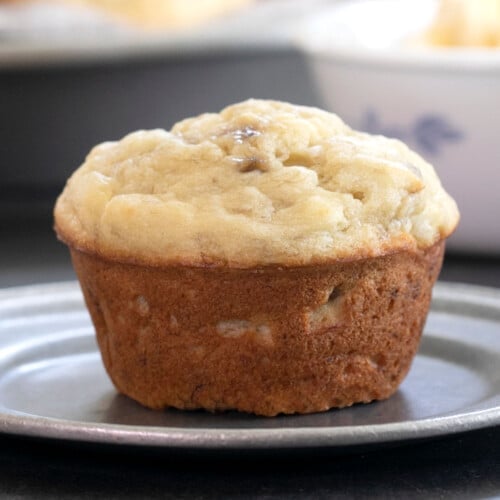
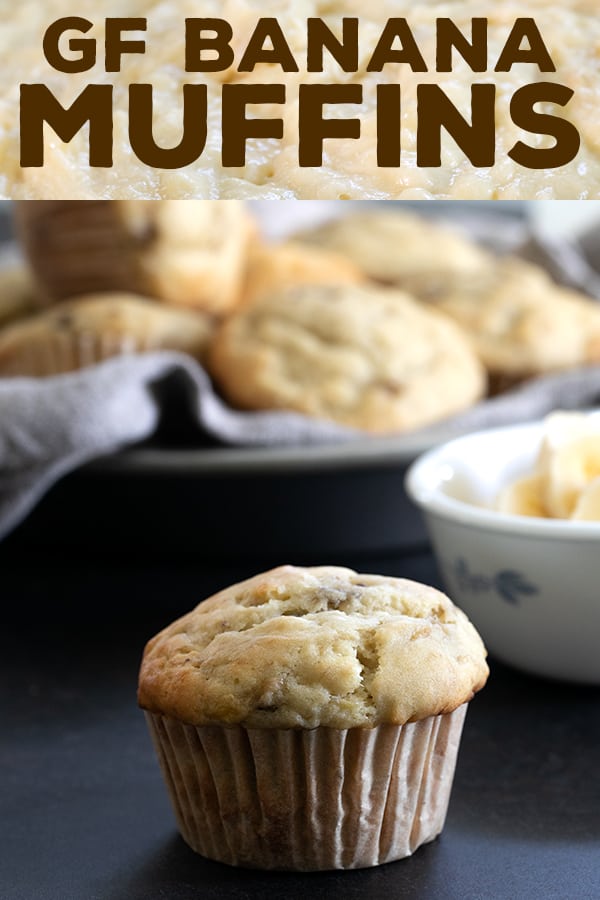

Phyllis D says
Another very good recipe. I followed the instructions exactly as written and the muffins turned out moist, soft, and delicious. I cannot have buttermilk, so I did Nicole’s swap with Siggi’s nondairy yogurt and lactose free milk, and it was perfect. I will say it again, invest in a small, inexpensive food scale! I weighed my eggs out of the shell and only needed 2 and 1/2 eggs to reach the proper weight. Baking is chemistry so precision matters. The recipe as written made exactly 16 muffins if you fill the muffins as instructed.
Nicole Hunn says
So true, Phyllis, baking is chemistry and precision matters! I’m so glad you enjoyed the recipe, and I love that buttermilk swap. It’s really versatile, whether you’re using dairy free components or not! Thank you so much for sharing your experience.
Alexandra Wilk says
Hi Nicole:
Can I use gf tapioca flour instead of the cornstarch?
If so, how much?
Thank you.
Nicole Hunn says
I don’t recommend that, no, as tapioca flour is a unique starch with lots of stretchy qualities that you don’t want more of here. In place of cornstarch, you can use an equal amount of potato starch or arrowroot if you can’t have corn.
MimiAlexa says
These are amazingly light fluffy. The whole family loved them. Nobody knew that they were GF! I added about a cup of chopped Walnuts and got 24 Muffins, so froze half for another time. This recipe goes to the top of my GF list! Now I can’t wait to try your other recipes! Thanks so much!
Mike Colquhoun says
I’ve been using your recipes to bake gluten free stuff for quite some time now and there are some great recipes.
I have a few comments to make and the main one is the amount of sugar you use in a lot of recipes is way over the top and very unhealthy. Again if it is cakes we are baking then more sugar is required but for things like banana muffins for example, the bananas are already sweet and also the vanilla is sweet and therefore does not in my opinion need anywhere near 150g of sugar. I use 50g and it is plenty sweet enough and doesn’t take away from the texture at all.
The second one is your aversion to psyllium husk. I can fully understand that you feel that there is a taste that it leaves that you don’t like but I have to say that psyllium husk is way better than xanthan gum in terms of binding the mix together and gives a far better texture. I personally get no taste from the psyllium but fully appreciate that this is a personal thing and everybody is different.
Please don’t take this as criticism as I’m a big fan of your recipes and use them all the time.
Nicole Hunn says
Mike, I’m publishing your comment, but I don’t believe it contains accurate information, so I’m responding to correct it. Whether you intended it as criticism or not, my response has nothing to do with hurt feelings. It’s with respect to the information itself.
There is no more sugar in my recipes than there is in conventional recipes of each type. Your opinion is not backed by science. Sugar isn’t just a sweetener. It’s a tenderizer, which is why fat free baked goods tend to be loaded with sugar. These recipes use a conventional amount of sugar. I don’t do “low sugar” or “sugar free” baking because it requires a lot more than just reducing sugar in a recipe not developed with that in mind to make good baked goods with the expected taste and texture. Viewing my recipes through the lens of “healthy eating” in general is a mistake, as I’m not that sort of blogger. I wouldn’t expect you to criticize a healthy blogger’s recipes as too low in sugar. In addition, gluten free baked goods already get criticized as being subpar. My entire purpose is to elevate people’s expectations. Perhaps a keto blog would suit your tastes better? And as a point of reference, pure vanilla extract has a very pleasant taste and aroma, but is not at all sweet and cannot make up for missing sugar in a recipe.
About psyllium husk, please do whatever works for you, but I won’t recommend or agree with anyone else’s recommendation for its use in my recipes here on my blog, as they will come to me for support when things don’t go as planned. I’m afraid I simply won’t provide that support. There are many recipe developers that use this ingredient, and make recipes intended for it, and I respect them and their efforts very much. It isn’t a simple 1:1 substitute for xanthan gum at all, in fact, and if I were one of those bloggers, I’d hate to see someone recommending that as if it were simple and foolproof. That’s why I won’t offer my suggestions on something that is an entirely different, and respected, way of baking in its own right.
My insistence on specificity in my recipes, and following a recipe carefully, isn’t for everyone, but I stand by it 100%.
Cindy Ranuio says
I love this recipe, but I substitute Guar Gum for the Xanthum Gum, I stopped using Xanthum Gum years ago, it was way too stringy, sticky kind of dough. With the Guar Gum, it is just like I am cooking with regular gluten type of way, it pours, and flows like I have experienced for all the years I baked with wheat flour before going gluten free. Just a suggestion.
Nicole Hunn says
I’m glad you found something that works for you, Cindy. It sounds like you were using too much xanthan gum in your baking, which is why it’s important to use it sparingly, and according to a recipe. For others’ benefit, xanthan gum is considerably more effective for baked goods than guar gum. Guar gum is most useful in cold applications, like ice cream.
Beth says
Awesome!
Blue Gate Farmgirl says
Made this recipe to share with the neighbor. I used 1/2 c whole milk yogurt and 1/2 c whole milk in place of the buttermilk. This recipe is my favorite go to banana muffin recipe. Always a hit. This made 18 muffin tops baked w/Nicole’s directions for 13 minutes.
Annie Deweese says
Hi! I’ve been looking for a good gluten free banana muffin recipe for quite a while. Do you think I could use Measure 4 measure GF flour blend in place of your gf flour blend? I have it already and hoping it will work with this recipe.
Thank you so much!
Nicole Hunn says
That is not a properly balanced flour blend, Annie, and tends to be of inconsistent quality. The rice flour is gritty as well.
JM Bugatti says
I would greatly appreciate it if you include recipes that are gluten free and dairy free baked goods. It is difficult to find delicious gluten free recipes that are also dairy free. I am confident if anyone is able to come up with such recipes it is you! Thank You.
Nicole Hunn says
I don’t specialize in dairy free recipes, although there are other bloggers who. All I can really offer is suggestions on how to make any given recipe dairy free as well, which you can find in the “ingredients and substitutions” section of each recipe post.
Cary says
Making the all purpose GF flour seems so complicated with specialty ingredients that are not easily found in stores and even online it gets expensive. I get discouraged every time I consider making or buying GF flours. I’ve been sticking to a basic blend of rice flour, tapioca starch and xanthan gum, although it is not a perfect texture but is simpler for my busy life.
Nicole Hunn says
I understand, Cary, and there are plenty of blogs out there with recipes that are less exact and produce “okay” results. This is not that blog, though. It sounds like you know what works for you, and you should go find it!